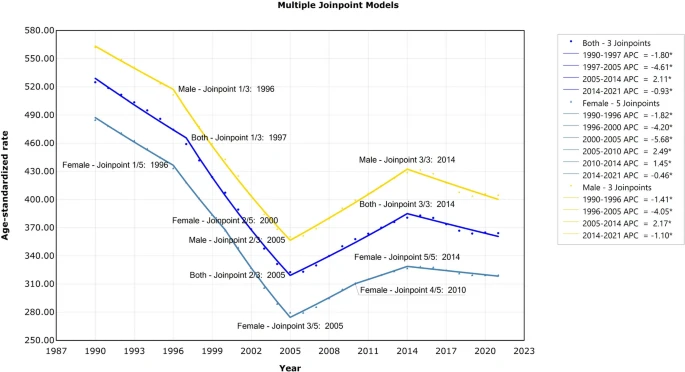
Li, N., Xu, Y., Xiao, X. et al. Respir Res 26, 56 (2025). https://doi.org/10.1186/s12931-025-03135-7
Abstract
Background
To develop effective strategies for controlling asthma, a thorough assessment of its disease burden is essential. In this study, we examined long-term trends in the asthma burden in China over the past three decades and analyzed its epidemiological features.
Methods
We assessed the burden of asthma in China via the global burden of disease (GBD) 2021 database, focusing on prevalence, incidence, mortality, years of life lost (YLLs), years lived with disability (YLDs), and disability-adjusted life years (DALYs). Additionally, we employed joinpoint analysis and age-period-cohort (apc) methods to interpret the epidemiological characteristics of asthma. Finally, we analyzed the attributable burden of asthma to gain a comprehensive understanding of its impact.
Results

The age-standardized incidence rate (ASIR) and mortality rate (ASMR) for both sexes in China shifted from 524.81 (95% UI: 421.31, 672.76) to 314.17 (95% UI: 283.22, 494.10) and from 5.82 (95% UI: 4.46, 8.50) to 1.47 (95% UI: 1.15, 1.79) per 100,000 population between 1990 and 2021. According to joinpoint analysis, the average annual percentage change (AAPC) in the age-standardized incidence rate was – 1.2 (95% CI: – 1.4, – 1.1), indicating a gradual but fluctuating decline (with significant turning points in 2005 and 2014). The apc fitting results suggest that the prevalence is now lower than it was in the past and that the relative prevalence risk is high among adolescents and middle-aged to elderly individuals, possibly due to different pathophysiological mechanisms. In 2021, the primary asthma-related burdens were metabolic risks, especially obesity.
Conclusions
In conclusion, we found that the disease burden of asthma in China has significantly decreased. However, it remains a major concern among adolescents and elderly individuals. Metabolic risk factors, particularly obesity, are the main contributors to the asthma burden. It is essential to address specific risk factors and develop targeted public health strategies for different age groups.
